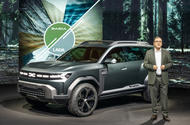Under Denis le Vot, Dacia is doubling down on making great-value cars offering only the kit they need
Dacia’s budget-friendly mission puts it in a good position amid the cost of living crisis
The price of cars is creeping ever upwards as the cost of raw materials increases. Meanwhile, a cost of living crisis is impacting the ability of consumers to buy new cars.
In the middle of a Venn diagram of brands well equipped to use these two conundrums as an opportunity to grow sits just one brand: Dacia. It famously keeps its models as lean as possible as part of a focus on ‘essentials’, which has many benefits, among them using less raw material and therefore the ability to keep costs low.
Pre-Covid, Dacia had grown in size every year, and it’s now doing so once again, and then some. In Europe, it’s the number-three brand on retail sales, despite not offering a model above the B-segment. And while market conditions may be suppressing for almost every car maker, Dacia senses a coming of age moment. Only MG is doing anything similar, albeit with more expensive (but still proportionally excellent value) electric cars.
At the top of Dacia is CEO Denis Le Vot, a Group Renault veteran of 30 years. To call him an effervescent character would be an understatement. He has been Dacia CEO since January 2021, a role that was given even greater meaning after Renault Group boss Luca de Meo’s ‘Renaulution’ plan emerged later that month, giving the brand far greater autonomy.
This week, Dacia has outlined its plans for the coming years, essentially doubling down on what it does already: making great-value cars that offer only the kit they need and no more. But with wallets being squeezed across almost all household incomes, Dacia is finding even more affluent buyers are being attracted to its proposition.
We met Le Vot in Paris earlier this week at the announcement of these plans. Buzzing around a room of 100-plus journalists, he can be a hard man to pin down, and he speaks so quickly that he can give your writing hand cramp trying to keep up. No word is wasted; every nugget is a genuine insight. You can read the full interview here.
Le Vot’s overall message is clear: the world is changing fast, and it’s getting ever closer to being aligned with Dacia’s values and proposition. He points to the Jogger as an example. The new MPV costs €10,000 less than the nearest rival, so customers order the Dacia in its fully loaded trim and it still comes out at a lower price than the most basic version of the next rival.
Behind that speed of thought lies passion but also expertise. This is a leader who knows his customers in the most minute detail; what are they asking for next? Electric wing mirrors as standard, it turns out. Talk about having the finger on your pulse of the minutiae.
Le Vot is also a skilled businessman, known to have decoupled Dacia from its tie-up with Russian firm Lada with minimal fuss earlier this year. Nor is he afraid of confrontation: Euro NCAP has goaded Dacia with many public statements about its commitment to safety and low or no-star ratings for its cars. Le Vot says he cares deeply about safety, but passive safety rather than active safety. “We don’t sell you lane-keeping assist as we know you turn it off,” he says.
Dacia was “always kept small” by being paired with Renault, says Le Vot, until it was granted its own autonomy last year. As its performance shows, it’s already flying, with plenty more to come, most notably with the launch into the C-segment in 2023 with the Bigster SUV.
Out of crisis comes opportunity, and no car maker is better placed to exploit it than Dacia.
Source: Autocar
